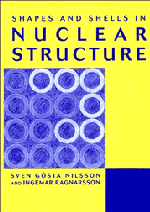Book contents
- Frontmatter
- Contents
- Preface
- 1 Naturally occurring and artificially produced nuclei
- 2 Charge and matter distribution in nuclei
- 3 The semi-empirical mass formula and nuclear stability
- 4 Nuclear fission and the liquid-drop model
- 5 Shell structure and magic numbers
- 6 The nuclear one-particle potential in the spherical case
- 7 The magnetic dipole moment and electric quadrupole moment for nuclei with closed shells ±1 nucleon
- 8 Single-particle orbitals in deformed nuclei
- 9 The shell correction method and the nuclear deformation energy
- 10 The barrier penetration problem – fission and alpha-decay
- 11 Rotational bands – the particle–rotor model
- 12 Fast nuclear rotation – the cranking model
- 13 The nucleon–nucleon two-body interaction
- 14 The pairing interaction
- Solutions to exercises
- References
- Index
11 - Rotational bands – the particle–rotor model
Published online by Cambridge University Press: 12 January 2010
- Frontmatter
- Contents
- Preface
- 1 Naturally occurring and artificially produced nuclei
- 2 Charge and matter distribution in nuclei
- 3 The semi-empirical mass formula and nuclear stability
- 4 Nuclear fission and the liquid-drop model
- 5 Shell structure and magic numbers
- 6 The nuclear one-particle potential in the spherical case
- 7 The magnetic dipole moment and electric quadrupole moment for nuclei with closed shells ±1 nucleon
- 8 Single-particle orbitals in deformed nuclei
- 9 The shell correction method and the nuclear deformation energy
- 10 The barrier penetration problem – fission and alpha-decay
- 11 Rotational bands – the particle–rotor model
- 12 Fast nuclear rotation – the cranking model
- 13 The nucleon–nucleon two-body interaction
- 14 The pairing interaction
- Solutions to exercises
- References
- Index
Summary
A general frame for the description of rotational states in nuclei was set in the beginning of the fifties by Bohr (1952) and by Bohr and Mottelson (1953). Rotation is a typical example of a collective degree of freedom in nuclei. A collective excitation is characterised by the coherent movement of a large number of nucleons. Thus, an elementary understanding of collective excitations is often achieved from macroscopic models. One example is nuclear fission, which could be considered as some kind of very large amplitude shape vibration. It is then also straightforward to introduce shape vibrations in general as a collective degree of freedom as illustrated in an elementary way in problem 10.2. In a more general context, shape vibrations can be described for example by the variation around the equilibrium value of the αλµ parameters introduced in chapter 4. The most important and first non-trivial mode corresponds to λ = 2, quadrupole vibrations.
When describing nuclear quadrupole vibrations in the laboratory system, one has to introduce all the fiveα2µ shape parameters. These can, however, be transformed to a body-fixed system where two parameters describe deformations, namely in the ε2 (or β2) and the γ degrees of freedom (the γ parameter was introduced in chapter 8). The three additional parameters then describe the orientation of the body-fixed system, e.g. by the three Euler angles. These three parameters thus describe the rotational motion, which is treated in the present chapter and continued in chapter 12. Vibrations, on the other hand, will not be treated here but instead we refer to the literature, e.g. Rowe (1970) and Eisenberg and Greiner (1987).
- Type
- Chapter
- Information
- Shapes and Shells in Nuclear Structure , pp. 181 - 205Publisher: Cambridge University PressPrint publication year: 1995



